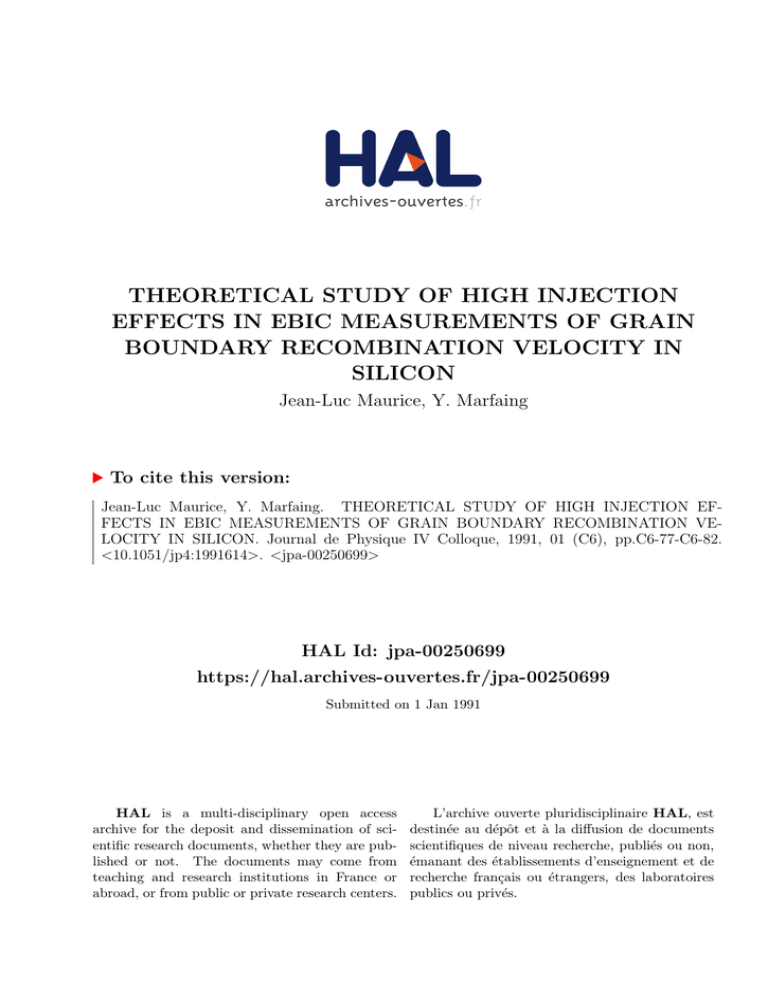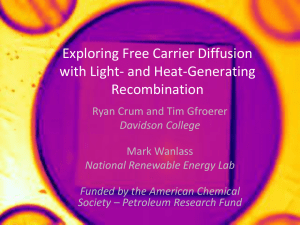theoretical study of high injection effects in ebic measurements
advertisement

THEORETICAL STUDY OF HIGH INJECTION
EFFECTS IN EBIC MEASUREMENTS OF GRAIN
BOUNDARY RECOMBINATION VELOCITY IN
SILICON
Jean-Luc Maurice, Y. Marfaing
To cite this version:
Jean-Luc Maurice, Y. Marfaing. THEORETICAL STUDY OF HIGH INJECTION EFFECTS IN EBIC MEASUREMENTS OF GRAIN BOUNDARY RECOMBINATION VELOCITY IN SILICON. Journal de Physique IV Colloque, 1991, 01 (C6), pp.C6-77-C6-82.
<10.1051/jp4:1991614>. <jpa-00250699>
HAL Id: jpa-00250699
https://hal.archives-ouvertes.fr/jpa-00250699
Submitted on 1 Jan 1991
HAL is a multi-disciplinary open access
archive for the deposit and dissemination of scientific research documents, whether they are published or not. The documents may come from
teaching and research institutions in France or
abroad, or from public or private research centers.
L’archive ouverte pluridisciplinaire HAL, est
destinée au dépôt et à la diffusion de documents
scientifiques de niveau recherche, publiés ou non,
émanant des établissements d’enseignement et de
recherche français ou étrangers, des laboratoires
publics ou privés.
JOURNAL DE PHYSIQUE IV
Colloque C6, supplement au Journal de Physique III, Vol. 1, decembre 1991
C6- 7 7
THEORETICAL STUDY OF HIGH INJECTION EFFECTS IN EBIC MEASUREMENTS OF GRAIN
BOUNDARY RECOMBINATION VELOCITY IN SILICON
J.-L. MAURICE and Y. MARFAING*
Laboratoire de Physique des Matériaux, CNRS-Bellevue, 1 Place Aristide-Briand, F-92195
Meudon Cedex, France
*Laboratoire de Physique des Solides de Bellevue, CNRS-Bellevue, 1 Place Aristide-Briand,
F-92195 Meudon Cedex, France
Abstract : The presence of carriers in the grain boundary (GB) space charge is
taken into account in solving numerically Poisson's equation. This allows one,
by using a schematic description of electron excitation, to investigate the
theoretical behaviour of the GB recombination velocity, measured by EBIC, in
high injection conditions.
1. Introduction.
The electron beam induced current (EBIC) measurement of the recombination velocity
(v s ) at the grain boundaries (GB) in silicon is of interest for both fundamental
research and photovoltaic industry. The link between v s and the physical parameters
of the GB traps (density N,, energy in the gap Et and capture cross sections for
electrons and holes <xn and a p ) is however quite complex. We recently proposed / l / a
set of relations allowing one to deduce these parameters from EBIC measurements of
vs at varying temperature and injection level. However, for sake of simplicity, the
presence of carriers in the GB space charge was either not considered (high
barriers) or introduced very roughly (low barriers) and the carrier transport in
this zone was also described in a schematic way.
In this paper, the presence of charge carriers in the Space Charge Region (SCR) is
fully taken into account in Poisson's equation and this, in turn, allows one to use
rigorous expressions for the minority and majority carrier currents (the only
neglected phenomena are injection and recombination in this region). While high
injection is likely to frequently occur in EBIC experiments, the present treatment
has the advantage to allow, for the first time, to investigate theoretically the
effects of such excitation conditions on the GB recombination velocity. This is
performed on two fictional grain boundaries representative of the ones existing in
p-type large grain polysilicon. The previous simplified model is simultaneously
applied and comparison with the present calculation indicates its validity limits.
2. Modelling of the presence of excess carriers in the grain boundary SCR.
Poisson's equation can be written
(1)
Article published online by EDP Sciences and available at http://dx.doi.org/10.1051/jp4:1991614
JOURNAL DE PHYSIQUE
IV
+
Energy
0
-
50
Ec
1
E fn
-P -
-bcpl
E fp
j
E"
X
b
illuminated
area
Fig.1. Energy level diagram in the vicinity of a grain boundary under
local excitation. The GB is at x = - W ; x = 0 corresponds to the edge of
the GB space charge region. Other notations are defined in the text (the
curves are arbitrary and do not reflect a real situation).
where cp is the electrostatic potential energy, x the spatial coordinate (Fig.l), q
the elementary charge, E E , the silicon dielectric constant, and N, the acceptor
concentration (we assume a p-type bulk material, form and results would be
symmetrically identical for n-type) . The existence of free carriers in the SCR is
represented by the x-dependent concentrations of electrons n(x) and holes p(x),
=
N, exp c,/kT
,
P(X) =
N, exp E,/kT
,
n(x)
where N,, N,, are the densities of states at the conduction and valence band edges
respectively, kT is Boltzmann's constant times the temperature and En, Ep are the
x-dependent chemical potentials of, respectively, electrons and holes.
Integrating equation (1) over electrostatic potential and using the Gauss theorem
allows one to derive the charge of the zone (on one side of the GB) :
=
[2..,
(N,
p e x p ndcp
E~
-
N,
t
where rp, is the barrier energy height (cq,
The electron current in the SCR is
En
exp -d
kT
=
- q
Q~~
where E, is the electron quasi Fermi level, Ern =
This expression can be put in the form :
rp
- N,rp,
11
of ref./l/)
cp
+
E,
I"
In steady state, this current is exactly compensated by the hole current which
takes a similar form :
i, = b N, exp-€P
kT
dEP dcp.
dm)dxY
(1
--
is the minority carrier electron mobility and p, is the standard hole mobility.
Equation (3) has to be integrated numerically by varying cp. One then needs to know
E, (cp) and E, (cp) . This is obtained by extracting dEn,,/dq from eqs (5a and 5b) :
pn
where we have used the relation i n + i p
eq. (3) taking cq, = cp.
=
dcp
dx
0. The quantity (-),,,
is deduced from
3. Current continuity and electrical neutral i ty.
The current given in (5a) is equal by continuity on the one hand to the
recombination current (i) at the GB which is related to the physical parameters Nt,
E , an, up, and on the other hand to the current (ii) coming from the grain. Using
shock1 ey Read Hal 1 (SRH) theory /3,4/, current (i) is :
where a
=
r, /rn , r
,
=
v,g, rn = vn un, with v,, v,, the thermal velocities of
electrons and holes respectively; p , n, are the carrier concentrations at the GB
and n, , p, are respectively the evectron and hole concentrations that would exist
if the Fermi level were at the trap energy E . The current from the grain (ii) is
solution of the diffusion equation for x > b /1/ and makes the 1ink with both v,
and the excitation rate g :
, is the excess carrier concentration at the edge of the space charge, D is the
minority electron diffusivity, Ln is the electron diffusion length and is the
An
a
C6-80
JOURNAL DE PHYSIQUE IV
r a d i u s o f t h e generation sphere /2/,
where E, i s t h e beam energy.
The generation r a t e g i s taken constant i n s i d e t h e i n t e r v a l [-d, + d l - except i n
t h e SCR where i t i s n o t taken i n t o account - and n u l l outside. The g value can be
derived from t h e beam c u r r e n t I, and t h e beam voltage E, by assuming a uniform
generation w i t h i n t h e generation sphere :
where 3.7 eV i s t h e e l e c t r o n h o l e p a i r c r e a t i o n energy.
Q u i t e generally, e l e c t r i c a l n e u t r a l i t y i m p l i e s t h a t t h e t o t a l charge o f t h e SCR, 2
x Q , i s equal and opposite t o t h e charge trapped a t t h e GB which i s given by t h e
~ c h o ke?y - ~ e a-Hal
l
1 expression /3,4/ ( f o r a donor-1 ike recombination centre) :
4. S o l v i n g t h e problem.
Ib b u t o n l y t h e f i r s t f o u r are actual
The parameters are Et , N , on, up, T, E,
unknowns. However t o gek useful curves, we f ~ ax l l o f them except t h e beam c u r r e n t
Ibwhich i s allowed t o increase r e g u l a r l y over a given range. The a l g o r i t h m f o r a
given I, value proceeds as f o l l o w s :
i ) a t r i a l value i s given t o An,
in
i s then c a l c u l a t e d from (8).
E, (p,
i i ) t h e s t a r t i n g values i n t h e i n t e g r a t i o n process are q = 0, E (no + An,),
an,).
The i n i t i a l d e r i v a t i v e s o f q, 5,
are c a l c u l a t e d using ?3), (6). Then q i s
given a small increment (-dq) and new iralues o f En, E, are deduced from t h e above
equations. The process i s repeated.
+
,
iii) A t each step j, Q,,
(eq.3) i s compared t o t h e q u a n t i t y Q,
(obtained by
p u t t i n g n j = n and p j = p, i n eq.11). I f 2 x Q,,
=
t h e i n t e g r a l i o n over q i s
terminated and !he computer proceeds t o i v .
a,.
i v ) A new value o f i i s c a l c u l a t e d using t h e expression o f t h e recombination
c u r r e n t a t t h e GB ?eq. (7)), from which a new value o f An i s deduced through (8).
The whole process i s i t e r a t e d u n t i l t h e f i r s t and f i n a l values o f An, are equal.
F i n a l l y , v, i s c a l c u l a t e d using (8).
5. P r a c t i c a l r e s u l t s and conclusions.
The two systems chosen are g r a i n boundaries i n p-type s i l i c o n (p, = 1016cm-3, Ln =
30 m), w i t h t h e f o l l o w i n g t r a p c h a r a c t e r i s t i c s and operating c o n d i t i o n s E, = E, +
0.45 eV, an = o, = 1 0 - l 5 cm2, T = 300 K, Eb = 20 keV. The t r a p d e n s i t y N, i s p u t
v, (lo3cmd' )
v, (cm 6 ' ) Barrier height (eV)
Barrier height (rneV)
0.2
- 0.1
Beam current (A)
Beam current (A)
(a)
(b)
Fig.2. Recombination v e l o c i t y v,
and b a r r i e r height
as a function o f beam
current I, a t a beam energy o f 20 keV, f o r (a) a GB w%h a density o f hole traps
near mid-gap o f N = lo1 cW2 (so
= 0.039 eV) and (b) a GB w i t h N, = 1012cm-2(%,
= 0.28 eV), (T = ~ O K ,kT = 0.025 eV).
Carrier concentration ( ~ r n - ~ )
90
Carrier concentration ( ~ r n - ~ )
Beam current (A)
(a)
Fig.3.
Concentrations o f electrons (n ) and holes (p,) a t the GB, and o f excess
space charge region, as a function o f beam
c a r r i e r s (An, ) a t the edge o f the
current I , f o r (a) the low barrier-GB ('4, = 0.039 eV) and (b) the high barrier-GB
( s o = 0.58 eV). The e q u i l i b r i u m conceneration o f holes i n the grains i s po=
1016cm-3 ; i n case (b) t h e equilibrium values a t the GB are ,n,
=lo9 cmV3 and pbo =
2 x 1OI1 ~ r n ' ~ .
GB
JOURNAL DE PHYSIQUE 1V
C6-82
equal to lo1
(example (a)) and to 1012cm-2 (example (b)) which correspond
respectively to equilibrium barrier heights of 0.039 eV and 0.285 eV considering
the trap states as single donors. These values have been chosen to match those
generally found in the litterature /5/. The calculations have been performed over a
range of beam current wider than that of standard electron microscopes by more than
one order of magnitude on the low as well as on the high range sides. The behaviour
of recombination velocity v, and barrier height cpb as a function of beam current is
presented in Fig. 2. Figure 3 shows the correlated evolutions of the carrier
concentrations at the GB ( n, and p,) and at the edge of the SCR ( A n , ) . Three
regimes successively occur as a function of excitation rate.
*
-
Regime 1 corresponds to the so-called low injection regime. It is characterized
by the condition n, << p,. This regime only appears in case (a) (low barrier) and
for current below 10-13A (Figs.2a and 3a). This gives a first important result :
standard GBs in Si - which have barrier heights above 0.2 eV /5/ - cannot be
studied in the low injection regime in usual EBIC experiments. In our example (b)
(%, = 0.28 eV), the majority and minority carrier populations are already inversed
at I, = 10-I3A (Fig.3.b).
*
-
Regime 2 is an intermediate regime, which corresponds to the experimental
10-1°A).
conditions most often used (I,
The recombination velocity monotonously decreases with increasing injection. Fig.2
shows that this behaviour was already correctly described in our previous model
(which indeed well fitted experimental results /I/) (dotted curves in Fig.2). The
slight discrepancy at low currents in case (b) is due to the fact that the absolute
1imi t of recombination velocity was arbitrari1y put equal to the thermal velocity
in /1/ (- 107cm s-l) while it comes out of the calculation in the present work (v,
(1 im) = 2.8 x 106cms-l ). Replacing the imposed value by the calculated one corrects
the discrepancy.
*
Regime 3 corresponds to the cases where the presence of carriers in the GB space
charge cannot be schematically described, model /1/ does not apply anymore. This
region is surprisingly characterized by a behaviour of the recombination velocity
similar to that observed in the low injection case : the absence of dependence on
excitation rate. This brings a second important result. The experimental
observation of a constant recombination velocity over a narrow beam current range
cannot be taken as a proof a low injection, one must investigate a range wide
enough to include regime 2. Fig.3 indicates that electron and hole concentrations
are equal in regime 3 (and equal to the excess carrier concentration), which
corroborates the quasi anihilation of the barrier (Fig.2). O f course our
description of the charge transport in the neutral region which considers the
existence of majority and minority carriers is particularly weak in this case.
However, considering ambipolar diffusion is not 1i kely to change the behaviour
observed.
Future work could be directed to a better treatment of this transport problem.
However, carrying out experiments in the high injection range - which can easily be
performed in any SEM - seems to be a priority.
REFERENCES.
/1/ MARFAING, Y. and MAURICE, J.-L., to be published in Springer Proc. Phys., 54
.(1991).
/2/ EVERHART, T.E., and HOFF, P.M., J. Appl. Phys., 42 (1971) 5837.
/3/ SHOCKLEY, W . , and READ Jr, W.T., Phys. Rev. 87 (1952) 835.
/4/ HALL, R.N., Phys. Rev. 87 (1952) 387.
/5/ GROVENOR, C.R.M. (Review), J. Phys. C 18 (1985) 4079.


